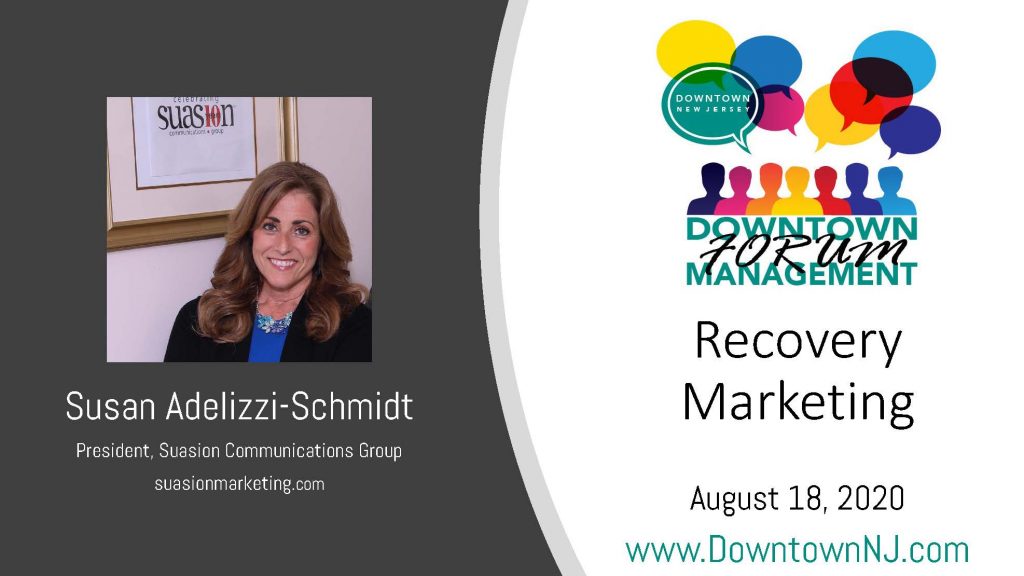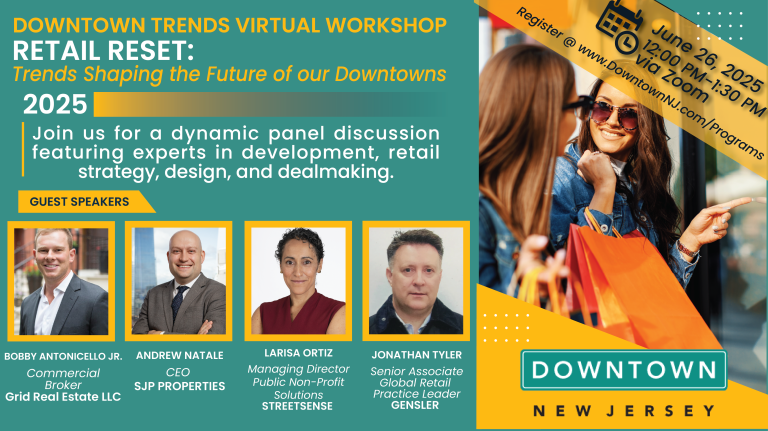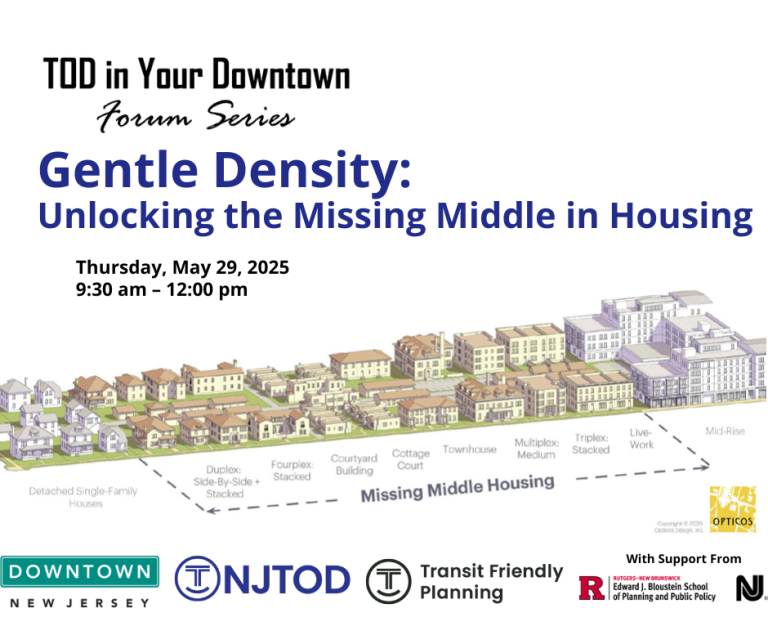Recovery Marketing
Courtenay D. Mercer, PP, AICP
Executive Director, Downtown New Jersey
Rachael Thompson Panik
Associate Planner, Mercer Planning Associates
August 18, 2020
Downtown New Jersey provided a series of virtual opportunities for downtown managers, economic development professionals, and public officials to exchange ideas about best practices related to downtown economic development in light of the COVID-19 crisis.
We are still a long way from business as usual here in NJ. As communities move into recovery mode, downtown managers and public officials will need to enhance their marketing strategy to boost consumer confidence, champion small business, and promote downtown as a place to invest. At this forum, seasoned communications expert Susan Adelizzi-Schmidt of Suasion Communications Group, led a discussion about public relations, digital marketing, and creative brand strategy for downtowns in recovery.
View Powerpoint>
Susan Adelizzi-Schmidt is the president of with Suasion Communications Group, and a board member of Downtown New Jersey. Suasion Communications Group is a full-service marketing agency with two offices in New Jersey. During this forum, Susan shared advice about how communities can market their downtown recovery efforts, highlighting her work with Downtown Haddonfield as an example.
Townships and downtowns are pivoting marketing efforts dramatically. Typically, marketers talk about the four P’s: PLACE, PRODUCT, PRICE, AND PROMOTION. Now, downtowns and marketers are also talking about PIVOTING, as that has become so essential to success during rapid and uncertain change. Downtowns can take advantage of this moment in time. While it has caused some businesses and downtowns to struggle, they can also seize the opportunity to make changes that will set them up for success in the future.
In particular, downtowns that are effectively navigating the challenges of the COVID-19 pandemic are those that are making information readily available. Downtown organizations cannot overcommunicate right now, as people are getting their information through so many different channels, including press, social media, flyers, and more. Success comes from providing the latest reminders, updates, and critical information to downtown businesses and consumers alike.
In addition to this general advice, Susan provided more pointed marketing tips for downtowns as they recover:
- Review the how the pandemic affected all of your stakeholders. The impact for some stakeholders has been acute and immediate, while others are feeling the effects more slowly. Given how quickly changes are coming, the impacts themselves will change constantly, so it is crucial that downtown managers, leaders, and marketers seek feedback constantly. While many downtown organizations and townships have already successfully pivoted once, likely they will again need to pivot in the near future as reopening expands (and potentially contracts again).
- Assess current messaging. Customers who typically frequent downtowns are now falling into one of five categories: the worriers, including seniors and vulnerable people who are not leaving their homes; the individualists, who are not afraid and desire freedom; the rationalists, who are wearing masks and following guidelines, but still getting out to shop and support local businesses; the activists, including those who are scolding others’ behavior on social media or otherwise in order to play a role in changing minds; and the indifferent customers, who are craving normality and justifying that by espousing that the pandemic has been blown out of proportion. It is paramount to understand which of these categories describes your downtown customers, and then tailor messaging for them. Determine what needs to be changed in your messaging or eliminated altogether.
- Determine what to pause and change immediately. Do not be afraid to pause campaigns if they are inappropriate for the time and place. Feel free to hold on to those campaigns until more normalcy returns, but it is better to put something on hold than to seem insensitive or ignorant to the effects of the pandemic.
- Develop a COVID-19 specific marketing and PR Campaign. Create new plans for communicating what is happening in your downtown and disperse those messages through the appropriate modes of communication. Clearly communicate assets to visitors, residents, and stakeholders. Haddonfield recently released a reopening campaign that was picked up by local news media. Local news outlets are looking for positive stories to tell about their communities, so be sure to take advantage of the opportunity. For this campaign, they used graphics that matched the downtown’s branding for consistency. They also released the Haddonfield: We Care campaign to highlight mask wearing and in-store safety measures. Both campaigns had corresponding press releases and other forms of coverage. They are seeing the results of this strategic approach – businesses are actually booming despite a challenging few months in April/May. Haddonfield has close to a 98% occupancy rate, and they are seeing both new businesses opening and expansion of existing establishments.
- Convert print messaging to digital messaging. Right now, digital messaging is getting the most attention. Notable exceptions include existing hyper-local print distributions that had high readership before the pandemic.
- Interact with downtown customers. Highlight people celebrating downtown in a safe manner. Showcase people in town with a story to tell, even if it is not selling anything in particular. For example, The Betsy is a hotel in Miami is curating online educational content relevant to their business, but that is not actually promoting their hotel in any specific way. The material showcases architects and designers talking about historic design characteristics of Miami. People are missing these human elements during the pandemic, so they will gravitate toward narratives and learning.
- Send regular informative email messages. Email marketing campaigns have been working really well for Haddonfield and other communities.
- Check on your stakeholders. Be there for your owners, customers, and leaders as much as you can. These are tough times, so supporting business owners in a personal way is sometimes just as helpful as supporting them with marketing.
- For important initiatives, consider print mailings. While this can be an expensive means of communicating with stakeholders, snail mail can actually cut through the online clutter for the highly important messages.
Discussion and Q&A:
- Showing people enjoying themselves in downtowns while still being socially distant is important. These are not normal times, and this is not business as usual. So, the images you share should make that apparent. Many shoppers have fears about being out, and the images we share should demonstrate that they can engage in public life and do it safely.
- There is such value in sharing stories. For example, during Bloomfield Restaurant Week, businesses who had not engaged in digital advertising in the past, shared their stories through short video clips. The effort proved fruitful with increased business.
- Frenchtown is a beautiful town along the Delaware River with a historic downtown. They have been hesitant to market themselves too much for fear of getting overrun with visitors, and not being able to accommodate the foot traffic in a safe manner. People are already flocking to the area to enjoy the river with their families, but they are not shopping in downtown. How have others dealt with concerns about large crowds and safety?
- Typically, Point Pleasant hires seasonal law enforcement officers during peak tourism season. Their infrastructure is more capable to accommodate large crowds, which may not be the case in historic Frenchtown. Some businesses have employed ambassadors to remind people in and around their stores of social distancing practices and mask wearing, so the businesses themselves have taken action to help without the entire burden falling to police.
-
- In Lambertville, they have been expanding sidewalks into parking spaces to better accommodate more people, but same have taken this as a sign that downtown is closed. They are now working to make a main roadway one-way to enable businesses to expand into the street, coupled with adding lively street activity (music, artists, etc.) to remind people that downtown is open.
-
- Celebrate Westwood has been focused on placemaking, creating small areas all over downtown where people can sit, “hang out”, or eat their take-out food, as well as to bring people through downtown to promote shopping and dining. They are keeping programs like movies in the park more local than in the past and are requiring registration to keep the numbers manageable.
- As it relates to social media, how do you best communicate the brand of the downtown? How do you develop a brand and communicate it effectively?
- Start with brand discovery through a series of meetings with stakeholders (business owners, elected officials, residents, consumers, etc.). A brand is a promise, it is an experience. A brand is not just a logo, but a representation of something bigger. What do you think of when you say that name?
Haddonfield has presents itself as a one-of-a-kind destination and the premier downtown in the Delaware Valley. They have been true to themselves – you have to be able deliver what you promise.
- There is truth to the need for engaging stakeholders in the branding campaign. For example, the Jersey City “Make it Yours” brand did not come about from an open process. Many started using it in a derogatory/sarcastic way, and it was ultimately dropped.
- Start with brand discovery through a series of meetings with stakeholders (business owners, elected officials, residents, consumers, etc.). A brand is a promise, it is an experience. A brand is not just a logo, but a representation of something bigger. What do you think of when you say that name?
- Early on, in Ridgewood, they started a “Feed the Frontlines” campaign that raised funds to pay for meals prepared by local restaurants to be delivered to hospitals and first responders. Once things started opening back up, they supported the businesses with a pedestrian mall that is open Saturdays & Sundays. They also tried one-way sidewalks, but it was not well-received. The pedestrian mall started out with just a few restaurants, but as they were successful, other joined. They also brought in musicians – now it looks and feels like a lively piazza in Italy. It is a large effort that may not be sustainable, and is not as effective for retailers. Ridgewood have also been using social media very effectively to highlight all their businesses in a personal way.
- As a regional center, Englewood’s challenge is that with two county highways and a major thoroughfare, it was not possible to close the streets to expand commerce. Instead, they established an outdoor garden in a parking lot that four restaurants are using. They also have smaller restaurants who are providing tables on the sidewalk in front of their stores, and some next-door merchant neighbors have allowed restaurants to encroach upon their storefronts.
- On weekends (Thursday through Sunday), New Brunswick closes George Street where a good portion of their restaurants are, and allows parklets for restaurants on side streets. They also worked with the parking authority to provide a 15-minute grace period for meter parking and free 30-minute parking in the main garage to enable people to grab take-out.
New Brunswick is about to start the “Re-Launch New Brunswick” campaign, which includes a promotional commercial. They are thinking about bringing in larger music acts and roaming artists, but are concerned about managing crowds. They want to promote it, but not as “an event” in order to help keep the crowds more manageable. Participants suggested using the artists to self-promote the event to their followers, which would garner a smaller, but dedicated audience that are likely chomping at the bit to see their favorite artists. Another example is the HDSID, who is doing a live event on the rooftop of a business with limited seating, and then promoting the streaming event.
- Downtown Westfield recently hosted a “foodie stroll” that had an overwhelming response that overwhelmed the restaurants and diminished the overall experience for the customers. The turnout demonstrated the pent-up demand to return to some semblance of normalcy. They are now thinking about how to retool the event to enhance the customer experience. Participant suggested running it like a ticketed food tour, or doing a restaurant week with the same small plate/drink specials that would have been offered at the stroll.
- The Central Jersey Jazz Festival is a three County-seat event (Flemington, Somerville, and New Brunswick), which Flemington is doing this year as a virtual event from a barn. Because it will be streaming, they expect a much larger audience, so how do they effectively promote a real downtown during a virtual event?
- Susan Adelizzi-Schmidt suggested that anything you do is good, even if it doesn’t come out the way you thought it would. Adjust and move on. For the event, there are ways to corral this through ticketing/reservations.
-
- Another participant thought a commercial is very important for these virtual events – take advantage of the eyes on the virtual event that may have had limited knowledge about your downtown before – it seems like a high ROI opportunity.
-
- Another suggestion is partnering with smaller nearby communities to do “watch parties” using technology/supplies they already have for movie nights. Advertise that the main event is in town X but has limited capacity, so you can join the watch party in towns Y and Z – hopefully getting “buts in seats” in all the towns.
- All of our downtown businesses need to compete with the easy to shop Amazon. A lot of the stores do have online stores, but they have no clue about marketing or positioning themselves. How do you create a “virtual downtown” to promote e-commerce?
- For Bloomfield Restaurant Week, they included info on the website about how the businesses wanted consumers to patronize them.
-
- In Haddonfield, they host ongoing seminars for their downtown business owners about hot topics/needed expertise.
-
- Suasion Communications Group was selected along with a couple of other companies by the NJEDA to provide e-commerce technical assistance to small businesses (ecomerce@njeda.com).
-
- Some BIDs have robust business directories on their own websites (see Metuchen Downtown and Summit Downtown), and others are sponsoring the creation of “virtual downtowns” through third party sites like Beyond Main.



